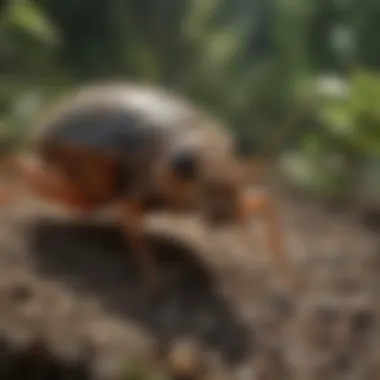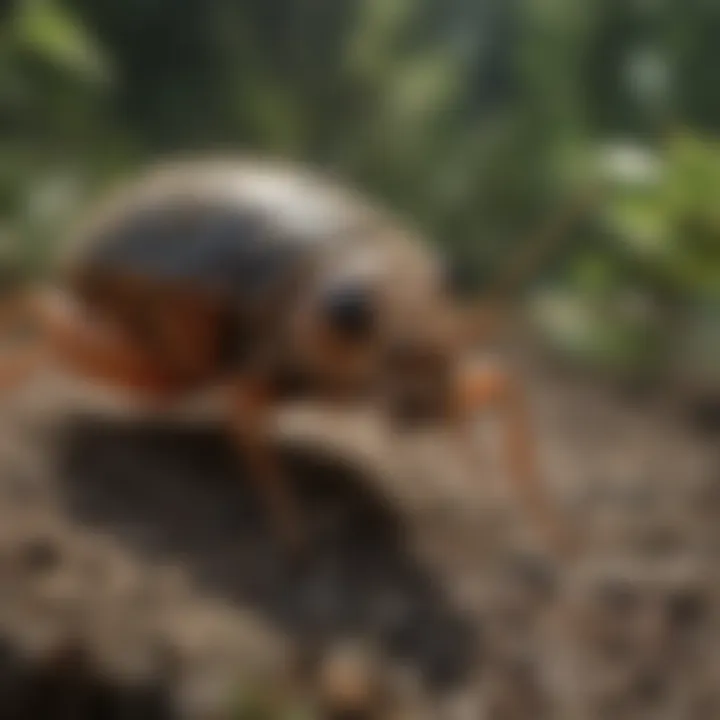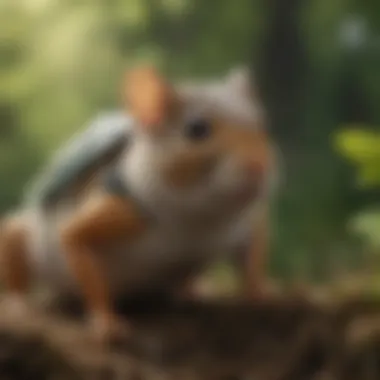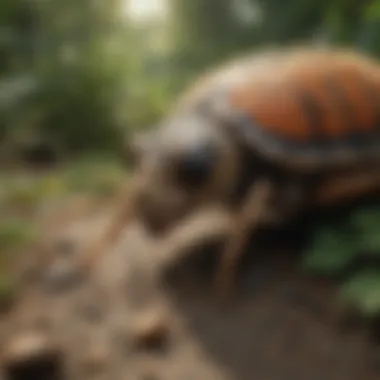Understanding Pest Management Strategies in Michigan


Intro
The landscape of pest management in Michigan is intricate and deserves careful examination. Homeowners in this state confront a unique set of challenges due to the diverse array of pests that thrive in its varied climate and geography. An understanding of how these pests operate is essential for developing effective control strategies. This article aims to provide insightful perspectives on the pest management practices suitable for the residents of Michigan, emphasizing eco-friendly approaches along with community involvement. Through an exploration of both identification and life cycle of pests, coupled with prevention and control methods, this resource serves to equip house owners with valuable knowledge.
Understanding the Pest
Identification
To manage pests effectively, one must first identify them accurately. Michigan's native and invasive pests include a wide range of species such as ants, termites, and various insects. Each type poses unique threats to homes and gardens. Correct identification goes beyond recognizing their physical characteristics; it requires understanding their behaviors and natural habitats. For instance, the carpenter ant can be confused with other similar species but knowing its nesting habits is crucial to address infestations.
Life Cycle
Understanding the life cycle of pests is equally important. Many pests undergo various developmental stages, from egg to adulthood, and different stages can require different management strategies. For example, the common crop pest, the aphid, reproduces rapidly in warm weather, often leading to large infestations in a short span. Knowing when they are likely to breed helps in scheduling preventive measures before they become a significant problem.
"Simple measures taken at the right time can save homeowners from larger infestations later on."
Pest Prevention Strategies
Environment Modification
Adopting the right environment modification techniques can significantly deter pests before they can establish themselves. This may include removing standing water that attracts mosquitoes or sealing cracks in walls to prevent entry. Ensuring that food is stored properly and waste is disposed of in a timely manner also plays a critical role in pest management, reducing the allure for various insect species.
Physical Barriers
Physical barriers are also an effective way to combat pest invasions. Utilizing screens on windows and doors, or erecting fencing tailored to keep out deer or rabbits, can drastically decrease pest-related issues. Installing traps can also serve as a preventive measure for larger animals that may invade gardens or properties.
Control Methods
Chemical Control
When prevention fails, chemical control methods may be necessary. Chemical pesticides can be effective in managing infestations, but they must be used judiciously. There are various types available, ranging from synthetic options to natural pesticides derived from plants. Each type has different implications for health and the environment.
Biological Control
As the pest control field evolves, biological control is increasingly becoming an accepted method. This approach utilizes natural predators to control pest populations. For instance, ladybugs can be highly effective at managing aphids in gardens. Such strategies not only reduce reliance on chemicals but also promote a healthier ecosystem.
In summary, the dynamics of pest management require a multifaceted approach that incorporates identification, prevention, and direct control measures. By integrating community knowledge and eco-friendly practices, residents in Michigan can enhance their pest management strategies to safeguard their homes while maintaining ecological balance.
The Unique Ecosystem of Michigan
The state of Michigan presents a distinct ecosystem characterized by diverse geographical features and climatic conditions. This uniqueness has significant implications for pest management practices. Pest populations thrive in environments that support their life cycles and natural behaviors. Recognizing the ecological characteristics of Michigan helps develop targeted pest control strategies.
Geographic and Climatic Influences
Michigan's geography is marked by its Great Lakes, rolling hills, and varied soil types. This diversity influences the ecology of pest species found in the region. The state's climate, with its cold winters and warm summers, creates specific challenges and opportunities for pest proliferation.
Seasonal changes in temperature and moisture levels greatly affect pest behavior. For instance, certain pests may become dormant in winter, while others might seek shelter indoors. Understanding these geographic and climatic dynamics is essential for effective pest management.
Common Pests in Michigan
Pest populations in Michigan include a variety of species that adapt to the unique temperate climate. Identifying these common pests is a vital part of pest management strategies.
Invasive Species
Invasive species pose a significant challenge to Michigan's ecosystem. These pests often arrive without natural predators. Their growth can disrupt local fauna and flora. A notable example in Michigan is the Emerald Ash Borer. Its rapid spread has devastated ash tree populations.
The key characteristic of invasive species is their ability to rapidly occupy new ecological niches, often leading to ecological imbalances. For pest management, it is critical to monitor and address these species quickly, as their established presence often makes control difficult.
Seasonal Variations in Pest Populations
Pest populations in Michigan fluctuate seasonally due to temperature, humidity, and food availability. Warm summers may trigger an increase in certain pests such as mosquitoes and ticks. Conversely, cold winters tend to reduce populations of many insects, but those that survive can emerge in substantial numbers come spring.
The seasonal pattern is important for pest control strategies, as it informs when to implement preventive measures. Homeowners can utilize this information to make informed decisions regarding pest control, ensuring that efforts are timely and effective.


Understanding the dynamics of seasonal variations empowers homeowners to anticipate pest surges and maintain their living environments more effectively.
In sum, recognizing and understanding the unique ecosystem of Michigan is foundational to crafting effective pest management approaches. By being aware of geographic and climatic influences, alongside the seasonal behavior of common pests, individuals can take proactive steps to manage potential infestations.
Integrated Pest Management Approaches
Integrated Pest Management, or IPM, is a fundamental aspect of pest management in Michigan. This approach is essential due to its multifaceted nature, which combines different strategies to control pest populations effectively and sustainably. IPM takes into account the life cycles of pests, their natural enemies, and environmental factors. One of the significant benefits of IPM is its emphasis on reducing the reliance on chemical pesticides, which can have harmful effects on the ecosystem and human health. By integrating various control methods, IPM promotes a balance where pests are managed with minimal disruption to their natural enemies and the surrounding environment.
Definition and Principles of IPM
Integrated Pest Management is defined as a sustainable approach to managing pests that combines biological, cultural, physical, and chemical tools in a way that minimizes economic, health, and environmental risks. The core principles of IPM involve:
- Monitoring: Keeping track of pest populations and predicting their impact.
- Assessment: Evaluating the severity of pest threats based on established thresholds.
- Prevention: Implementing strategies to deter pests before they become a problem.
- Control: Applying effective methods to manage pest populations using the least harmful options first.
These principles guide the decision-making process and help ensure that pest management strategies are both effective and environmentally sound.
Components of Effective IPM
Effective IPM consists of several components that work together to manage pest populations. Two key elements are Monitoring and Identification, and Prevention and Control Techniques.
Monitoring and Identification
Monitoring and identification are critical in the IPM process because they provide the necessary data to make informed decisions. This involves regularly checking for pest activity and accurately identifying pest species. One of the key characteristics of this component is its emphasis on data-driven decisions; it ensures that actions are based on pest life cycles, population numbers, and potential damage.
Monitoring and identification are beneficial because they allow homeowners and pest control professionals to detect issues early before they escalate. A unique feature is the use of traps and surveys to gather information, which can lead to targeted interventions. However, it requires consistent effort and knowledge, which can be a disadvantage for those unfamiliar with pest biology.
Prevention and Control Techniques
Prevention and control techniques are fundamental to minimizing pest outbreaks and protecting assets like gardens and homes. These techniques include cultural practices, habitat manipulation, and biological controls. A key characteristic of prevention techniques is that they proactively address the factors that attract pests. For instance, proper sanitation and landscape management can significantly reduce pest populations.
This component is a popular choice because it focuses on long-term solutions rather than quick fixes, resulting in a healthier ecosystem. The unique feature of prevention techniques lies in their sustainability; using less harmful substances and emphasizing natural pest deterrents can lower environmental impact. Despite its advantages, some homeowners may find it challenging to implement these techniques due to the required knowledge and consistent upkeep.
"Integrated Pest Management not only addresses pest issues effectively but also promotes environmental stewardship and sustainability in our communities."
Using Integrated Pest Management approaches, homeowners can manage pests effectively while maintaining a commitment to their environment. This leads to healthier living spaces and a more significant understanding of the delicate balance between humans and nature.
Biological Control Methods
Biological control methods play a significant role in pest management strategies within Michigan. These methods leverage natural processes to regulate pest populations, thereby reducing reliance on synthetic pesticides. Utilizing biological control is not only beneficial for the environment but also crucial for long-term sustainability in pest management practices.
One key element of biological control is the employment of beneficial insects, which naturally prey on or parasitize pest species. This approach can effectively diminish pest populations while preserving the ecological balance of the area. By promoting biodiversity, biological controls help to ensure that ecosystems remain resilient and functional. Additionally, implementing these methods can often lead to cost savings in pest management, as they frequently require less financial investment compared to chemical treatments.
Role of Beneficial Insects
Beneficial insects are essential to biological control. These insects serve as natural enemies to pest populations. Their presence can drastically decrease the need for synthetic pesticides. Among the various beneficial insects, ladybugs and parasitic wasps stand out as effective agents in pest control. Both types contribute significantly to maintaining pest populations at levels that do not threaten agricultural production or residential comfort.
Utilizing Natural Predators
Ladybugs
Ladybugs, or Coccinellidae, are often considered a staple in biological pest control. They predominantly feed on aphids, a common pest that plagues plants in Michigan. The voracious appetite of ladybugs allows them to reduce aphid populations rapidly and efficiently. Notably, they have a unique ability to locate and consume aphids in various life stages, including eggs, larvae, and adults.
This characteristic makes ladybugs a popular choice among homeowners and gardeners looking for an eco-friendly pest management solution. However, there are considerations to bear in mind. While ladybugs are effective for controlling aphid populations, their impact on other pest species may be limited. Additionally, their effectiveness can vary based on environmental conditions and food availability.
Parasitic Wasps
Parasitic wasps represent another crucial component of biological control efforts. These tiny wasps lay their eggs inside or on pest insects, leading to the death of the host as the larvae develop. This method is particularly effective against pests like caterpillars and whiteflies. The presence of parasitic wasps can create a considerable dent in pest populations in agricultural settings.
Their key characteristic lies in their specificity; many species target only a few pests. This specificity can help reduce the chances of disrupting non-target insect populations, thus contributing to ecological balance. Nonetheless, the success of parasitic wasps can depend on various factors, including habitat diversity and the timing of their release.
"Biological control methods provide a sustainable and eco-friendly option for pest management, aligning with the increasing demand for environmentally responsible practices."
Chemical Pest Control Practices
Chemical pest control practices play a critical role in pest management strategies throughout Michigan. They provide essential tools for controlling pest populations that might otherwise damage crops or invade homes. Understanding these practices involves a closer look at pesticides, their types, and the regulations governing their use.


Types of Pesticides Used in Michigan
In Michigan, various pesticides are utilized to manage pest populations effectively. The primary categories include:
- Insecticides: Target insects, including both pests and beneficial species.
- Herbicides: Focus on controlling unwanted weeds to protect crops and plants.
- Fungicides: Combat fungal infections that can affect plant health.
- Rodenticides: Specifically designed for controlling rodent populations.
It is important to note that the selection of the pesticide often depends on the specific pest problem at hand, as well as the potential impact on the surrounding environment. Homeowners should consult local pest control professionals to determine the most effective choices.
Regulatory Considerations
Regulation of chemical pest control is paramount to protect public health and the environment. Several key considerations include:
- Registration Requirements: All pesticides must be registered with the Environmental Protection Agency (EPA) and the Michigan Department of Agriculture and Rural Development (MDARD) before they can be sold or used.
- Proper Labeling: Pesticides must display clear instructions on usage, safety precautions, and environmental impacts on their labels.
- Application Guidelines: Users must follow guidelines regarding the application rate, timing, and methods to ensure safety and efficacy.
- Reporting and Record-Keeping: Many states, including Michigan, require the maintanence of records related to pesticide use to track potential issues and effectiveness.
"Understanding the legal framework around pesticide use helps ensure the safety of both users and the environment."
Incorporating chemical pest control methods within an overall pest management strategy is crucial. Homeowners need to balance effectiveness with environmental stewardship. By being informed, individuals can make responsible choices that align with best practices in pest management.
Cultural Practices in Pest Management
Cultural practices are cornerstone strategies in pest management, especially within the diverse agricultural landscape of Michigan. These practices involve manipulating the environment and various agricultural techniques to manage pest populations effectively and sustainably. Understanding the significance of these practices can help homeowners and farmers reduce dependency on chemical controls and promote a healthier ecosystem.
The implementation of cultural practices not only targets pest management but also enhances agricultural productivity. Such methods can lead to better soil health, increased crop yield, and reduced pest incidence. Moreover, these practices are often more environmentally friendly, minimizing the impact of pesticides on local ecosystems. Key cultural practices include crop rotation and soil management, sanitation, and exclusion techniques.
Crop Rotation and Soil Management
Crop rotation is a fundamental cultural practice in pest management that involves changing the type of crop grown on a specific piece of land in successive seasons. This practice disrupts the life cycles of pests that thrive on specific plants, thereby reducing their populations. For instance, rotating corn with soybeans can diminish pest pressure, as many insects favor particular crops.
Soil management also plays a critical role. Healthy soil leads to stronger plants that are more resistant to pests. Practices such as adding organic matter, maintaining proper pH levels, and practicing cover cropping enrich the soil. These methods enhance the biodiversity within the soil, promoting beneficial organisms that can naturally curtail pest populations. Overall, both crop rotation and proper soil management create an ecosystem less conducive to pest establishment.
Sanitation and Exclusion Techniques
Sanitation in gardening and farming significantly impacts pest management. This involves removing dead plants, debris, and weeds that can harbor pests and pathogens. Regularly cleaning tools and equipment also helps mitigate the risks. Such proactive measures not only reduce the presence of pests but also limit their reproduction in affected areas.
Exclusion techniques are equally essential. This practice focuses on preventing pests from entering gardens and homes in the first place. Physical barriers, such as row covers, nets, and screens, can effectively block various pests from accessing vegetable patches or blooming flowers. In addition to using barriers, sealing cracks and gaps in structures helps deter unwanted pests from infiltrating indoor spaces. Implementing these sanitation and exclusion measures can considerably lower pest populations and lead to a more successful management strategy.
"Effective cultural practices serve as the first line of defense in a comprehensive pest management strategy."
The Importance of Community Engagement
Community engagement plays a critical role in pest management within Michigan. Pest issues are not solely the responsibility of individual homeowners or agricultural managers. A collective effort that includes residents, local agencies, and environmental groups enhances the effectiveness of pest control strategies. When people work together, they can share knowledge, resources, and solutions that might not be available to them individually.
One specific element is the increased awareness about local pest issues. Local communities can learn about the common pests in their areas and understand the risks they pose, which is vital for prevention. This knowledge-sharing leads to better practices in pest management, as residents can identify early signs of infestations and take appropriate actions. The community can conduct workshops or seminars to educate everyone about the importance of pest management.
Considerations surrounding community engagement also include the sharing of resources. Neighboring homeowners can collaborate to hire pest control services or purchase pest management products in bulk, reducing individual costs. This cooperative approach not only saves money but provides access to professional advice and comprehensive solutions that a single household might not achieve.
"Effective pest management is a community effort. Sharing information and tools creates stronger defenses against invasive species."
Additionally, community engagement fosters a sense of responsibility. When homeowners understand that they are part of a larger ecosystem, they become more invested in both their properties and their communities. This mindset encourages proactive behaviors such as maintaining gardens responsibly, using biological control methods, and limiting pesticide use in favor of eco-friendly practices.
Ultimately, the blend of education, shared resources, and a collective responsibility strengthens the community's resilience against pest challenges in Michigan. By empowering individuals to engage with one another and their environment, pest control becomes not just a task, but a shared mission.
Educational Outreach Programs
Educational outreach programs are essential to promote understanding and awareness of pest management techniques among the public. These programs can be organized by universities, local government, or non-profit organizations.
Such programs often focus on informing households about the life cycles of common pests, their behaviors, and the best practices for keeping them at bay. Many resources, including workshops, online seminars, and pamphlets, provide real-world strategies that residents can implement in their homes.
Furthermore, these programs often emphasize eco-friendly practices. For instance, they might promote using beneficial insects or organic pesticides that have less environmental impact. The adoption of these practices can lead to a significant reduction in pesticide use, benefiting both human health and local ecosystems.
In addition to increasing awareness, these outreach initiatives also foster community connections. They encourage residents to share their experiences, solutions, and techniques, creating an ecosystem of learning that can lead to improved pest control outcomes.
Collaborative Efforts in Pest Control
Collaborative efforts in pest control signify the importance of partnerships between various stakeholders. Local governments, agricultural organizations, and community residents must work together to devise sustainable pest management plans.


This collaboration often involves regular meetings and consultations. During these gatherings, participants can discuss pest outbreaks, share innovative techniques, and adjust management strategies based on current observations. This agility is vital as it allows communities to adapt to changing pest populations and environmental conditions.
Moreover, fostering partnerships can also lead to joint funding opportunities for pest management initiatives. Community members can band together to apply for grants or seek support from local businesses, further enhancing the resources available for pest control. In many cases, working together results in more significant impact measures than one entity can achieve alone.
These collaborative efforts are critical in addressing complex pest management issues in Michigan. As communities face challenges from climate change, invasive species, and diminishing natural predators, unity in approach becomes more important than ever.
Emerging Trends in Pest Management
The landscape of pest management is continuously evolving. Emerging trends play a crucial role in shaping strategies that not only target pests effectively but also adhere to sustainable practices. In Michigan, understanding these trends provides housewives and homeowners with the tools necessary to manage their environments responsibly. These trends include technological advancements and a shift toward more sustainable practices, both contributing to better pest management outcomes while minimizing environmental impact.
Technological Innovations
Advancements in technology have significantly transformed pest management practices. In Michigan, pest control has become more efficient due to several innovations that have enhanced the ability to monitor and combat pest populations.
- Smart Traps and Monitoring Systems: New devices can track pest activity in real-time. These traps use sensors to capture data and send alerts to users. Homeowners can then focus their control efforts based on accurate, timely information.
- Data Analytics: Big data techniques allow for the analysis of pest behavior and population trends. This information enables more precise application of pesticides, reducing unnecessary treatments. Homeowners can make informed decisions about when and how to address pest issues.
- Mobile Applications: Numerous apps have emerged that help identify pests quickly. Users can upload photos of pests, enabling a rapid diagnosis and effective treatment recommendations. This accessibility empowers homeowners to take immediate action when needed.
The integration of these technologies marks a significant improvement in pest management efficiency in Michigan, promoting not just effectiveness but also a proactive approach to pest control.
Sustainable Practices and Their Adoption
Sustainability is becoming a core consideration in pest management. Homeowners are increasingly acknowledging the need for methods that protect both their property and the environment.
- Eco-Friendly Pesticides: There has been a notable rise in the use of natural or organic pesticides. These alternatives are less harmful to beneficial insects and the ecosystem, promoting healthier living spaces.
- Integrated Pest Management (IPM): This approach combines cultural, biological, and chemical strategies. Homeowners can adopt IPM principles by starting with non-chemical methods such as encouraging beneficial insects or using natural repellents. This comprehensive view reduces reliance on chemical treatments.
- Community Initiatives: Local programs often promote sustainable practices and educate homeowners on pest management. Engaging with these initiatives can bridge the gap between personal pest management efforts and community health.
In summary, adopting sustainable practices not only helps homeowners manage pests more effectively in Michigan but also contributes to broader ecological health.
"Sustainable pest management is about working with nature—using technology wisely while ensuring the ecosystem thrives alongside our homes."
Overall, these emerging trends in pest management present exciting opportunities for homeowners. By embracing technological innovations and sustainable methods, they can enhance their pest control efforts, protect their homes, and promote a healthier environment.
Challenges in Pest Control
Effective pest control is an ongoing challenge for many in Michigan. The state's rich biodiversity presents unique pest management hurdles. Homeowners often find themselves battling various pest species that thrive due to diverse climatic conditions and geographic features.
One critical aspect of pest control is resistance management. Over time, certain pests develop resistance to commonly used pesticides. This phenomenon occurs when pests that possess genetic traits allowing them to survive exposures to pesticides reproduce, leading to populations that are increasingly difficult to control. The implications of this are significant as it forces both professional pest managers and homeowners to rethink their strategies. Integrated Pest Management (IPM) approaches emphasize the importance of rotating pest control methods, using multiple tactics, and employing non-chemical options. Identifying resistant populations quickly can aid in adjusting approaches to effectively manage these pests.
Another prominent challenge is the impact of climate change. Temperature increases and altered precipitation patterns influence pest life cycles and their geographical distribution. New pest species may emerge or expand their range into Michigan, creating additional pressures on local ecosystems. What was once a minor infestation can escalate into a significant pest problem under changing climate conditions. For instance, warmer winters may allow pests like the brown marmorated stink bug to survive and reproduce in greater numbers, putting further strain on management efforts.
Addressing these challenges requires an informed and proactive stance. Homeowners should be encouraged to stay engaged with ongoing education. This includes understanding which pests are prevalent and how changes in the climate can shift pest populations. Moreover, participating in local community pest management programs can enhance collective efforts against pest threats. Such involvement not only supports individual households but also contributes to broader ecological stability.
Quote: "The key to effective pest management lies in adapting strategies to ever-changing conditions, fostering resilience in our approaches."
In summary, the challenges in pest control within Michigan are multifaceted. Resistance management and climate change's impact are two critical areas that necessitate attention. As homeowners navigate through these challenges, they benefit from integrating knowledge and participation in community initiatives that strive for sustainable solutions in pest management.
Closure: A Path Forward
Understanding pest management in Michigan is a complex yet vital aspect that merges ecological balance and human activity. The conclusion of this article aims to encapsulate the significance of implementing effective strategies while highlighting avenues for future improvement in pest management practices.
As detailed throughout this article, adopting integrated pest management (IPM) approaches emphasizes both the necessity of monitoring and the importance of biological controls. This multifaceted perspective empowers individuals, particularly homeowners, to tackle pest issues with confidence and foresight without heavily relying on chemical interventions. The combination of traditional techniques with emerging technologies creates a more resilient pest management system, further enhancing sustainability within Michigan’s unique ecosystems.
"Effective pest management is not solely about removing pests; it's about creating a balanced environment that prevents infestations before they start."
The engagement of community in pest management cannot be overstated either. Active participation in educational outreach programs and collaborative pest control efforts fosters a collective sense of responsibility. This not only aids in pest control but also strengthens community bonds. When communities come together, pooling resources and knowledge, they become more effective problem-solvers.
In the face of evolving challenges such as climate change and pest resistance, a proactive and adaptive mindset is essential. The insights shared in the preceding sections serve as a foundation for homeowners to develop personalized pest control plans. This strategic thinking will play a crucial role in navigating the intricate dynamics of pest management going forward.
Summary of Best Practices
- Adoption of IPM: Focus on a combination of monitoring, prevention, and control methods.
- Community involvement: Engage in local initiatives and educational programs.
- Utilizing biological controls: Recognize the potential of beneficial insects and natural predators.
- Emphasis on sustainability: Implement eco-friendly approaches that reduce dependence on chemical pesticides.
By embracing these practices, individuals can actively contribute to the long-term health of Michigan’s ecosystem while effectively managing pest populations.
Future Perspectives on Pest Management in Michigan
The future of pest management in Michigan holds promise as new technologies and methodologies emerge. Innovating is key in addressing perennial issues like pest resistance and habitat alteration due to climate change.
Expect advancements such as cloud-based monitoring systems and data analytics that provide real-time insights into pest populations. Additionally, ongoing research into plant and insect relationships will likely lead to new biological controls that are more efficient and environment-friendly.
Ensuring education remains accessible to the community is also crucial. As homeowners become increasingly informed, they will be better equipped to adapt strategies that mitigate pests while preserving ecological balance. With knowledge comes empowerment, allowing communities to sustain their environments for generations to come.
In summary, as the dynamics of pest management evolve, we must remain vigilant and proactive. This readiness will pave the way for more effective practices, ultimately ensuring a harmonious coexistence between humans and pests.







